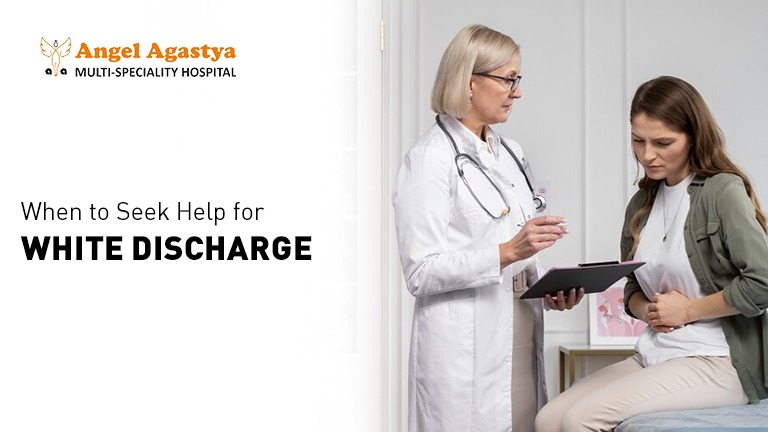Introduction:
White Discharge Noticed and feeling panicked?
You’re not alone! This is a natural occurrence, but let’s understand what it means.

Problem Agitation:
Seeing white discharge can be unsettling, triggering questions about hygiene, infections, and overall health. You might wonder if it’s normal, a sign of something serious, or how to deal with it.
Solution Introduction:
This guide takes the mystery out of white discharge. We’ll explore its causes, types, when to worry, and how to maintain healthy vaginal balance. Breathe easy, because knowing what’s normal empowers you to manage your health with confidence!
Understanding White Discharge:
It’s Normal!:
Reassure readers that white discharge is a natural and necessary part of a healthy vagina. It’s not a sign of poor hygiene, but a sign your body is functioning optimally.
The Housekeeping Crew:
Explain how the vagina produces discharge to keep itself clean. This discharge helps remove dead cells, fight off infection with healthy bacteria, and even lubricates during sex. It’s like a dedicated housekeeping crew working tirelessly for your well-being!

Types of White Discharge:
Discuss different types of white discharge, including consistency, odor, and timing in the menstrual cycle:
- Sticky white discharge: This is often seen mid-cycle and can be a sign of ovulation (when an egg is released for potential fertilization).
- Thick, white, and clumpy: This might be normal discharge, especially after ovulation or before your period.
- Watery white discharge: This is another normal variation, especially throughout your cycle.
Normal vs. Abnormal:
Highlight factors that differentiate normal discharge from a potential infection, like color, smell, and itching:
- Normal: White, milky, or clear discharge with no foul odor and minimal itching.
- Abnormal: Yellow, green, or gray discharge with a strong fishy odor or accompanied by intense itching, burning, or redness.
When to Seek Help:
Don’t Ignore Warning Signs:
Encourage seeking medical attention if the discharge is accompanied by:
- Itching, burning, or redness in the vaginal area
- A strong, foul odor
- Pain during urination or sex
- Unusual changes in consistency or color

Diagnosis:
Explain how a doctor diagnoses the cause of abnormal discharge through a pelvic exam and potentially tests like a swab to identify the culprit, such as yeast or bacteria.
Addressing Concerns:
Reassure readers that most causes of abnormal discharge are treatable with medication or home remedies prescribed by your doctor. Early diagnosis and treatment can prevent complications.
Maintaining Vaginal Health:
Hygiene Tips:
Offer practical advice on maintaining good hygiene practices to promote vaginal balance:
- Wash the vulva (outer vaginal area) with warm water and a gentle, fragrance-free cleanser.
- Avoid douching, which disrupts the natural balance of bacteria in the vagina.
- Take a clean towel & pat dry the area instead of rubbing.
- Wear cotton underwear that allows for breathability.
Ditch the Douching:
Explain why douching disrupts natural flora and can actually increase the risk of infections. Your vagina has a self-cleaning mechanism – let it do its job!

Cotton is King:
Promote the use of breathable cotton underwear for optimal comfort and ventilation. Tight-fitting or synthetic fabrics can trap moisture and irritate the delicate vaginal area.
Listen to Your Body:
Encourage paying attention to changes in discharge and consulting a doctor if needed. Your body is sending you signals – learn to interpret them!
Building Confidence:
Reiterate that understanding vaginal discharge empowers you to manage your health with confidence. Don’t be shy about talking to your doctor – they’re there to help!
Summary:
White discharge is a normal bodily function, not something to panic about. It plays a vital role in keeping your vagina clean and healthy. This guide has equipped you with knowledge about different types of white discharge and when to seek medical attention for abnormal changes. Remember, maintaining good hygiene practices and avoiding harsh products can promote vaginal balance. Most importantly, feel empowered to listen to your body and address any concerns with your doctor. They can help identify and treat any underlying causes for a healthy and comfortable you.
FAQs:
What causes abnormal white discharge?
Several factors can contribute to abnormal white discharge, including:
- Yeast infections: These are caused by an overgrowth of a fungus called Candida.
- Bacterial vaginosis (BV): This is an imbalance of healthy and unhealthy bacteria in the vagina.
- Sexually transmitted infections (STIs): Certain STIs like Chlamydia or Trichomoniasis can cause abnormal discharge along with other symptoms like burning or pain.
Can white discharge during pregnancy be a sign of something wrong?
White discharge is common throughout pregnancy and usually nothing to worry about. However, consult your doctor if you experience:
- A thick, white discharge with a cottage cheese-like consistency (could be a yeast infection)
- Greenish or yellowish discharge with a foul odor (possible bacterial infection)
- Bloody discharge (especially in early pregnancy)
Does white discharge affect fertility?
Yes, stress can indirectly affect vaginal discharge. Stress hormones can disrupt the menstrual cycle, which can cause fluctuations in discharge consistency and amount.
Is white discharge a sign of ovulation?
The presence of clear, stretchy white discharge around mid-cycle can be a sign of ovulation. This discharge is sometimes referred to as “egg white cervical mucus” due to its consistency and facilitates sperm movement.
Are there any home remedies for abnormal white discharge?
While maintaining good hygiene is crucial, it’s important to consult a doctor before trying home remedies for abnormal discharge. Self-treating can worsen the underlying condition.
Can certain medications cause white discharge?
Yes, some medications, like birth control pills or antibiotics, can cause changes in vaginal discharge as a side effect. If you experience a significant change and it bothers you, discuss it with your doctor.
Is white discharge contagious?
The contagiousness of white discharge depends on the cause. Yeast infections are not contagious, but some STIs that cause abnormal discharge can be spread through sexual contact.
Can white discharge cause urinary tract infections (UTIs)?
No, white discharge is not directly linked to UTIs. UTIs are caused by bacteria entering the urinary tract and causing inflammation in the bladder. Symptoms of a UTI typically include burning pain during urination, frequent urination, and possibly blood in the urine.
What are some healthy lifestyle habits to promote vaginal health?
- Maintain a balanced diet rich in fruits, vegetables, and yogurt with live cultures (promotes healthy bacteria).
- Engage in regular exercise to reduce stress and improve overall health.
- Get enough sleep for hormonal balance.
- Practice safe sex to prevent STIs.
What are some healthy lifestyle habits to promote vaginal health?
- Maintain a balanced diet rich in fruits, vegetables, and yogurt with live cultures (promotes healthy bacteria).
- Engage in regular exercise to reduce stress and improve overall health.
- Get enough sleep for hormonal balance.
- Practice safe sex to prevent STIs.
By understanding white discharge and maintaining healthy habits, you can promote vaginal balance and overall well-being. Remember, your doctor is your partner in maintaining good health. Don’t hesitate to ask questions and seek guidance whenever needed.

